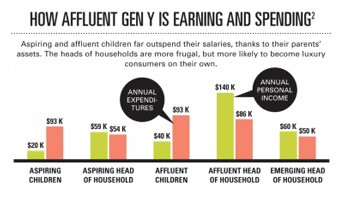While members of generation Y—Americans born between 1978 and 1994—have largely been set back by the economic downturn just as they entered the workforce, one report says a significant number are starting to spend big.
More from Urban Land:
- Generation Y: America’s New Housing Wave
- Housing Gen Y: The Next Challenge for Cities
“Affluence in America: The Next Generation” a report by advertising agency Digitas, finds 16.6 million gen-Y households with an annual income of $100,000 or more. That constitutes nearly one-third of the 53.3 million U.S. households earning that much, according to census data.
The report says one of its most important findings—and one of the most surprising—is that a large portion of big-spending gen Yers still live in their parents’ home. Members of this subset spend two to four times their own income. “It’s important not to count out this generation based on their personal income,” says George Scribner, senior vice president of account planning at Digitas. “Many of the younger affluent gen Y are grafting their parents’ income onto their own.”
Not only is the affluent segment of gen Y, “a sizable target that will likely gain in numbers,” according to the report, but it also has both the largest current spending and potential for increased spending for luxury items, and could be outspending the boomer generation as soon as 2017.
Those looking for growth opportunities need to “shift their focus” from the Baby Boom generation, whose luxury spending patterns are starting to age as they do, to Gen Yers, also called Millennials, whose spending patterns are very different, the report says.
This group is buying online and by phone, and relies heavily on the reviews and peer recommendations, but the in-store experience “is still sticky.” Milton Pedraza, CEO of the Luxury Institute in New York, is quoted as saying, “Surprise, the retail store is not going away.” This has lead some brick-and-mortar retailers to focus more on “showcasing” their products, offering more than an online experience can provide.
Other findings of the study:
- If a product represents an exclusive experience or gives the buyer bragging rights, affluent millennials will line up to be among the first to have it. (Imagine those lining up at an Apple store for the latest iPhone release.)
- Cause marketing and charitable tie-ins resonate. Affluent gen Yers believes in equality and are predisposed toward solutions that benefit many—or that at least pose no harm to others. “Buy one, give one” brands like TOMS, a shoe retailer, have capitalized on this sentiment.
- This group is “strongly driven” by the expectation of future wealth. Therefore, the study says, “marketers of luxury goods must balance catering to this group now with cultivating those who are building their own wealth and assets as they grow in their careers, and who will eventually support themselves in the luxury marketplace.”
“Gen Y is starting to enter the wealth-accumulation phase, and companies that are struggling should look ahead,” says Jason Dorsey, chief strategy officer of the Center for Generational Kinetics, a research and consulting firm. “As boomers move on, they’ll be spending less, but gen Y is just getting started.”






